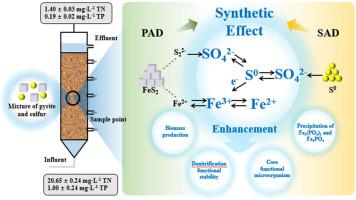Water Research ( IF 11.4 ) Pub Date : 2023-07-27 , DOI: 10.1016/j.watres.2023.120422 Zhiqiang Chen 1 , Chao Pang 1 , Qinxue Wen 1

|
The discharge standards of nitrogen (N) and phosphorus (P) in wastewater treatment plants (WWTPs) have become increasingly strict to reduce water eutrophication. Further reducing N and P in effluent from municipal WWTPs need to be achieved effectively and eco-friendly. In this study, a carbon independent pyrite and sulfur autotrophic denitrification (PSAD) system using pyrite and sulfur as electron donor was developed and compared with pyrite autotrophic denitrification (PAD) and sulfur autotrophic denitrification (SAD) systems through batch and continuous flow biofilter experiments. Compare to PAD and SAD, PSAD was more effective in simultaneous removal in N and P. At hydraulic retention time (HRT) 3 h, average effluent concentrations of total nitrogen (TN) and total phosphate (TP) of 1.40 ± 0.03 and 0.19 ± 0.02 mg/L were achieved when treating real secondary effluent with 20.65 ± 0.24 mg/L TN and 1.00 ± 0.24 mg/L TP. The improvement in simultaneous removal of N and P was attributed to the coupling of PAD and SAD in enhancing the transformation of sulfur and iron and enlarging the reaction zone in the pyrite and sulfur autotrophic denitrification biofilter (PSADB) system. Therefore, more biomass was accumulated and the microbial denitrification functional stability, including electrons transfer and consumption was enhanced on the surface of pyrite and sulfur particles in the PSADB system. Moreover, autotrophic denitrifiers (Thiobacillus and Ferritrophicum), sulfate-reducing bacteria (Desulfocapsa) and iron reducing bacteria (Geothrix), acting as contributors to microbial nitrogen, sulfur and iron cycle, were specially enriched. In addition, the leaching of iron ions was promoted, which facilitated the removal of phosphate in the form of Fe3(PO4)2·8H2O and Fe3PO4. PSADB has proven to be an efficient technology for simultaneous removal of N and P, which could meet increasingly stringent discharge standards effectively and eco-friendly.
中文翻译:

耦合黄铁矿和硫自养反硝化同时去除二级污水中的氮和磷:可行性、性能和机制
为了减少水体富营养化,污水处理厂(WWTP)中氮(N)和磷(P)的排放标准变得越来越严格。需要有效、环保地进一步减少城市污水处理厂出水中的氮和磷。本研究开发了一种以黄铁矿和硫为电子供体的碳独立黄铁矿和硫自养反硝化(PSAD)系统,并通过间歇和连续流生物过滤器实验与黄铁矿自养反硝化(PAD)和硫自养反硝化(SAD)系统进行比较。与PAD和SAD相比,PSAD在同时去除N和P方面更有效。在水力停留时间(HRT)3 h时,总氮(TN)和总磷酸盐(TP)的平均出水浓度分别为1.40±0.03和0.19±当用 20.65 ± 0.24 mg/L TN 和 1.00 ± 0.24 mg/L TP 处理真实二级出水时,可达到 0.02 mg/L。同时去除N和P的改进归因于PAD和SAD的耦合增强了硫和铁的转化并扩大了黄铁矿和硫自养反硝化生物过滤器(PSADB)系统中的反应区。因此,PSADB系统中黄铁矿和硫颗粒表面积累了更多的生物量,增强了微生物反硝化功能的稳定性,包括电子传递和消耗。此外,作为微生物氮、硫和铁循环贡献者的自养反硝化菌(硫杆菌和铁营养菌)、硫酸盐还原菌( Desulfocapsa)和铁还原菌(Geothrix )也被特别富集。此外,促进了铁离子的浸出,有利于以Fe 3 (PO 4 ) 2 ·8H 2 O和Fe 3 PO 4形式去除磷酸盐。PSADB已被证明是一种高效的同时去除N和P的技术,可以有效且环保地满足日益严格的排放标准。





















































 京公网安备 11010802027423号
京公网安备 11010802027423号